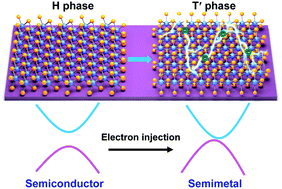当前位置:
X-MOL 学术
›
J. Mater. Chem. C
›
论文详情
Our official English website, www.x-mol.net, welcomes your feedback! (Note: you will need to create a separate account there.)
Electron-injection driven phase transition in two-dimensional transition metal dichalcogenides
Journal of Materials Chemistry C ( IF 6.4 ) Pub Date : 2020/02/12 , DOI: 10.1039/c9tc06410a Xiangyu Zhou 1, 2, 3, 4 , Haibo Shu 1, 2, 3, 4 , Qiuqi Li 2, 3, 4, 5 , Pei Liang 1, 2, 3, 4 , Dan Cao 2, 3, 4, 5 , Xiaoshuang Chen 4, 6, 7, 8, 9
Journal of Materials Chemistry C ( IF 6.4 ) Pub Date : 2020/02/12 , DOI: 10.1039/c9tc06410a Xiangyu Zhou 1, 2, 3, 4 , Haibo Shu 1, 2, 3, 4 , Qiuqi Li 2, 3, 4, 5 , Pei Liang 1, 2, 3, 4 , Dan Cao 2, 3, 4, 5 , Xiaoshuang Chen 4, 6, 7, 8, 9
Affiliation

|
Two-dimensional transition metal dichalcogenides (TMDs) have attracted considerable attention as potential building blocks for electronic and optoelectronic applications due to their polymorphism that creates the possibility to realize metallic and semiconducting properties in the same material. Here we report the electron-injection driven structural transition from the semiconducting H phase to semimetal T′ phase in MoX2 (X =S, Se, and Te) nanosheets based on density-functional theory (DFT) calculations. Our results show that the phase stability of MoX2 highly depends on the arrangement of Mo-4d orbitals and p–d hybridization between the Mo and X atoms. The addition of electrons onto the MoX2 basal plane increases the orbital occupation degree of d electrons in the T′ phase that enhances the T′-phase stability and reduces the phase-transition barriers, which contributes to the H-to-T′ phase transition. We demonstrate that the electron-driven phase-transition mechanism can be applied to explain broad experimental observations, including the realization of T′-phase MoX2 nanosheets by the intercalation of Li ions, hydrogen passivation, and defect engineering. The present work offers a basic understanding of semiconductor-to-semimetal transition in TMD nanosheets and opens up more possibilities to control the crystal phase of MoX2 for device applications.
中文翻译:

二维过渡金属二卤化物中电子注入驱动的相变
二维过渡金属二卤化物(TMD)由于其多态性而成为电子和光电应用的潜在构建基块,引起了相当大的关注,这创造了在同一材料中实现金属和半导体特性的可能性。在这里,我们基于密度泛函理论(DFT)计算,报告了MoX 2(X = S,Se和Te)纳米片中电子注入驱动的结构从半导体H相到半金属T'相的转变。我们的结果表明,MoX 2的相稳定性高度取决于Mo-4d轨道的排列以及Mo和X原子之间的p–d杂化。在MoX 2上添加电子基面增加了T'相中d电子的轨道占据度,从而增强了T'相的稳定性并减小了相变势垒,这有助于从H到T'的相变。我们证明,电子驱动的相变机制可以用于解释广泛的实验观察,包括通过嵌入锂离子,氢钝化和缺陷工程实现T'相MoX 2纳米片。本工作提供了对TMD纳米片中半导体向半金属过渡的基本理解,并为控制MoX 2在器件应用中的晶相开辟了更多可能性。
更新日期:2020-04-03
中文翻译:

二维过渡金属二卤化物中电子注入驱动的相变
二维过渡金属二卤化物(TMD)由于其多态性而成为电子和光电应用的潜在构建基块,引起了相当大的关注,这创造了在同一材料中实现金属和半导体特性的可能性。在这里,我们基于密度泛函理论(DFT)计算,报告了MoX 2(X = S,Se和Te)纳米片中电子注入驱动的结构从半导体H相到半金属T'相的转变。我们的结果表明,MoX 2的相稳定性高度取决于Mo-4d轨道的排列以及Mo和X原子之间的p–d杂化。在MoX 2上添加电子基面增加了T'相中d电子的轨道占据度,从而增强了T'相的稳定性并减小了相变势垒,这有助于从H到T'的相变。我们证明,电子驱动的相变机制可以用于解释广泛的实验观察,包括通过嵌入锂离子,氢钝化和缺陷工程实现T'相MoX 2纳米片。本工作提供了对TMD纳米片中半导体向半金属过渡的基本理解,并为控制MoX 2在器件应用中的晶相开辟了更多可能性。



























 京公网安备 11010802027423号
京公网安备 11010802027423号